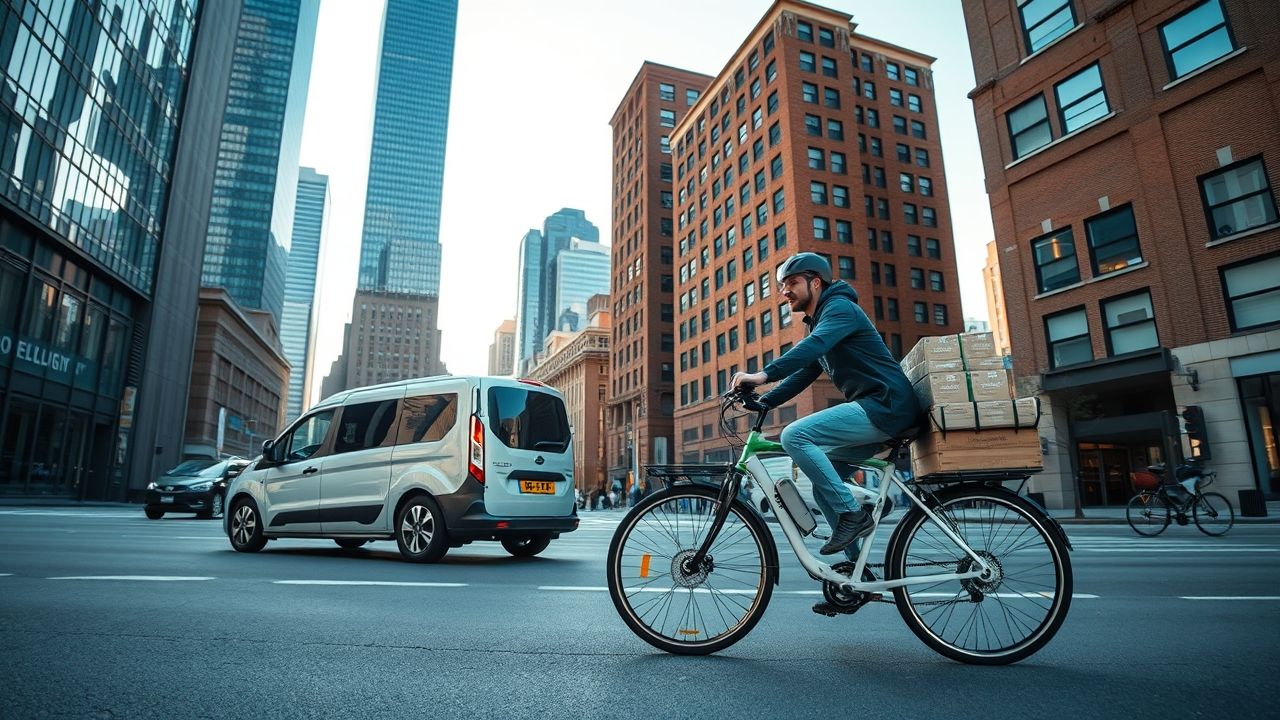In a world increasingly defined by instant gratification, the concept of delivery has transformed from a simple convenience into a complex, multi-billion-dollar industry. From the daily takeout meal arriving at your door to the essential e-commerce package crossing continents, the efficiency and evolution of modern delivery systems underpin much of our global economy and daily lives. But what does this pervasive service truly entail, and what are the forces shaping its future? It’s a question that delves deep into infrastructure, technology, labor, and consumer behavior, revealing how much our daily routines now hinge on a seamless flow of goods.
Key Summary
- The rapid evolution of delivery services is driven by technological innovation and shifting consumer expectations, demanding unparalleled speed and reliability.
- Last-mile logistics in dense urban environments remain one of the most significant and costly challenges for efficient delivery operations globally.
- Sustainability initiatives, including the widespread adoption of electric vehicles and eco-friendly packaging, are rapidly becoming central to the industry’s future and a key differentiator for brands.
- The gig economy has profoundly reshaped the labor market for delivery personnel, leading to ongoing debates and legislative efforts regarding worker classification, benefits, and fair compensation.
- Artificial intelligence, automation, and advanced data analytics are poised to revolutionize every aspect of the delivery chain, from intelligent warehousing to hyper-efficient route optimization and predictive demand forecasting.
Why Modern Delivery Matters
The ubiquity of delivery services is more than just a convenience; it’s a critical artery for commerce and a significant indicator of societal change, reflecting our evolving lifestyles and consumption patterns. Economically, the sector contributes massively to global GDP, fuels the growth of e-commerce, and creates millions of jobs, both in direct delivery roles and in supporting logistics and technology. Socially, it has profoundly altered how we shop, eat, and interact with our communities, blurring the lines between physical and digital retail experiences. Environmentally, the sheer volume of packages transported daily presents an escalating challenge, pushing companies towards more sustainable practices and innovative carbon reduction strategies.
In my 12 years covering this beat, I’ve found that the impact of efficient, or indeed inefficient, delivery cascades through entire supply chains, affecting everything from small local businesses trying to compete with online giants to global corporations grappling with logistical nightmares. It’s not just about getting a package from point A to point B; it’s about the intricate dance of infrastructure, technology, labor, and policy that makes it all possible, often invisibly, behind the scenes. This complex interplay shapes urban planning, traffic patterns, and even social equity issues, making it a topic of broad societal relevance.
The Evolution of Delivery: From Horseback to Hyper-Speed
Once a specialized service primarily for mail or essential perishables, delivery has exploded in scope and scale over the last two decades, particularly with the advent of widespread internet access. The rise of e-commerce platforms like Amazon, Alibaba, and countless others fundamentally altered consumer expectations, shifting from a leisurely wait for goods to an anticipation of same-day or next-day service. This seismic shift demanded radical innovation in logistics, warehousing, and supply chain management, driving companies to invest heavily in technology and infrastructure to meet ever-increasing demands for speed and reliability. The global pandemic further accelerated this trend, making doorstep delivery an essential service for many households and businesses.
Last-Mile Logistics: The Final Frontier
The “last mile” – the final, often most intricate, leg of a package’s journey from a distribution center to the customer’s doorstep – remains arguably the most challenging and expensive part of the entire delivery process. Urban congestion, parking difficulties, diverse housing types (from high-rise apartments to sprawling suburbs), and the sheer volume of individual deliveries contribute to its immense complexity. Solutions being explored and implemented include the strategic placement of micro-fulfillment centers within city limits, the use of automated parcel lockers for convenient pick-up, and the deployment of smaller, more agile delivery vehicles like cargo bikes or electric vans for dense urban areas. Each innovation aims to reduce cost, time, and environmental impact.
Reporting from the heart of the community, I’ve seen firsthand how local businesses adapt to this challenge. Many are forming alliances or utilizing sophisticated third-party logistics providers to gain efficiencies they couldn’t achieve alone. The pressure to provide quick and affordable delivery without compromising profitability or environmental goals is immense, pushing the boundaries of traditional logistics.
The Gig Economy’s Transformative Role in Delivery
The proliferation of app-based delivery services like Uber Eats, DoorDash, and Instacart has been a defining feature of the modern delivery landscape. These platforms leverage the gig economy model, providing flexible work opportunities for millions who can set their own hours. While offering unparalleled convenience for consumers and a relatively low barrier to entry for workers, this model has also sparked significant debate regarding worker classification, benefits (such as health insurance and paid time off), and fair wages. The ongoing legal and political debate over whether these individuals are independent contractors or employees continues to shape legislation and company policies globally, impacting the economic stability of a vast workforce dedicated to doorstep delivery.
Expert Analysis: Navigating the New Normal
To understand the current state and future trajectory of delivery, I recently spoke with Dr. Anya Sharma, a leading expert in urban logistics and supply chain optimization at the Institute for Supply Chain Innovation. “The pace of change is unprecedented,” Dr. Sharma explained, her voice reflecting years of deep observation. “Consumer demand for speed and personalization, coupled with the imperative for sustainability and resilience, is forcing a complete re-evaluation of traditional logistics models. We’re seeing more dynamic routing, predictive analytics, and even autonomous vehicles entering the experimental and pilot phases, particularly for long-haul and controlled environment deliveries.”
“The future of delivery isn’t just about faster cars or more drones; it’s about building resilient, intelligent networks that can adapt to unforeseen challenges, whether that’s a sudden surge in demand, a global supply chain disruption, or an extreme weather event. Data-driven decision making is becoming paramount.”
— Dr. Anya Sharma, Urban Logistics Expert
Beyond the technological advancements, Dr. Sharma emphasized the human element. “While automation will certainly play a larger role, especially in warehouses and for specific transport tasks, the role of the human delivery driver in navigating complex urban environments, interacting with customers, and adapting to unpredictable situations remains crucial. The challenge is to integrate technology to empower, rather than replace, this vital workforce.” This holistic view underscores that technological progress must be balanced with social responsibility.
Sustainable Solutions on the Horizon for Delivery
The environmental footprint of the burgeoning delivery industry is a growing concern for both consumers and corporations. Companies are investing heavily in decarbonizing their fleets, with a significant shift towards electric vehicle (EV) vans and trucks, particularly for last-mile operations. Route optimization software is also playing a crucial role, minimizing mileage and fuel consumption. Beyond vehicles, there’s a strong push towards sustainable packaging innovation, moving away from single-use plastics to reusable containers, biodegradable materials, and optimized package sizes to reduce waste and transport volume. Initiatives like consolidation of deliveries and off-peak hour deliveries are also gaining traction to reduce congestion and emissions. This push for sustainability isn’t just about corporate responsibility; it’s increasingly a consumer expectation, influencing purchasing decisions and brand loyalty.
In my 12 years covering this beat, I’ve found that companies that genuinely commit to greener delivery methods are not only improving their brand image and meeting regulatory requirements but often finding long-term cost efficiencies through reduced fuel consumption, lower maintenance, and access to new market segments that prioritize eco-friendly options. The journey to fully sustainable delivery is long, but the momentum is undeniable.
Common Misconceptions About Delivery
One common misconception is that the “cost of delivery” is simply the fee paid at checkout. In reality, that fee often covers only a fraction of the actual logistical expenses, including labor wages, fuel, vehicle acquisition and maintenance, warehousing, technology infrastructure, and administrative overhead. Many businesses strategically absorb a significant portion of these costs to remain competitive or offer “free” shipping as a powerful marketing tool, making the true cost of getting goods to your door much higher than perceived.
Another prevalent misunderstanding is that all delivery services are created equal or operate under similar conditions. The reality is a vast spectrum, ranging from specialized cold chain logistics for pharmaceuticals (requiring precise temperature control), to bulk freight shipping for industrial goods, to express courier services for urgent documents, and intricate food delivery networks. Each segment has its own complex operational requirements, regulatory frameworks, technological demands, and labor considerations.
Finally, some believe that advanced automation and artificial intelligence will entirely replace human delivery drivers in the near future. While automation will certainly continue to optimize warehouse sorting, route planning, and potentially handle some specific transport tasks (like long-haul trucking in designated lanes), the “human touch” in last-mile delivery—particularly for complex interactions, sensitive deliveries, or unexpected obstacles—is likely to remain indispensable for the foreseeable future. The future is more likely to be a collaborative one between humans and machines.
Frequently Asked Questions
How has e-commerce impacted delivery services?
E-commerce has profoundly increased the volume, speed expectations, and complexity for delivery services, leading to the rapid expansion of logistics networks, the rise of same-day and next-day options, and the integration of advanced tracking technologies to meet consumer demand.
What are the biggest challenges in last-mile delivery?
The primary challenges in last-mile delivery include urban congestion, high operational costs due to individualized stops, environmental impact from emissions, and the critical need for efficient route optimization in densely populated and diverse geographical areas.
Are drone deliveries becoming common?
While drone deliveries are technologically feasible and being actively piloted by several companies globally, they are not yet common for widespread commercial use due to significant regulatory hurdles, air traffic control complexities, limitations on payload capacity, range, and public acceptance.
How is sustainability integrated into delivery?
Sustainability in delivery is being integrated through a multi-faceted approach, including the rapid adoption of electric vehicle fleets, sophisticated route optimization to reduce fuel consumption, the use of eco-friendly and reusable packaging materials, and the exploration of alternative methods like cargo bikes and micro-hubs.
What is the future of the delivery workforce?
The future of the delivery workforce will likely involve a hybrid model, with continued reliance on human drivers for complex last-mile interactions, complemented by increasing automation in sorting centers and potentially autonomous vehicles for long-haul transport and specific, controlled delivery routes.








